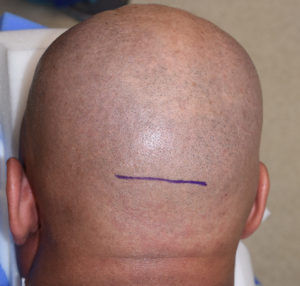Correction of flat and asymmetric back of the head deformities is unequivocally best done with a custom skull implant. Made from the patient’s 3D skull CT scan, the outline of the skull augmentation needed and the point of maximal projection and symmetric shape can be best achieved.
With a preformed skull implant, like any other preformed face or body implant, the goal of surgery becomes placement of the implant in the desired position and doing so through the smallest possible incision. Considerations of the implant design and shape have all been preoperatively determined and are generally not influenced by the immediate intraoperative result unless it appears substantially different than what was discussed before surgery.

The incisional length for occipital skull implants is usually 7cm to 9 cms placed centrally. Whether the head is shaved or hair is present, the incision is beveled to parallel the normal downward exit of the hair shafts which occur in most people in this scalp area. To minimize scarring and potential hair loss along the incision, only scalp and scissors are used until one is done at the level of the bone, well below the more superficial location of the hour follicles right under teh skin.
Dr. Barry Eppley
Indianapolis, Indiana


